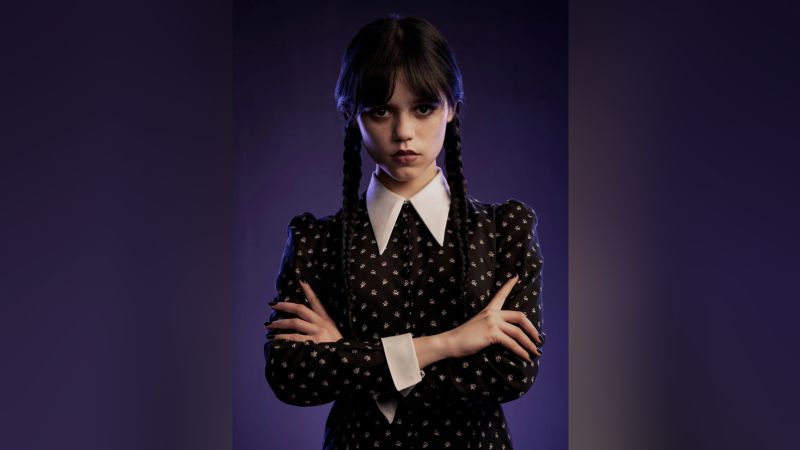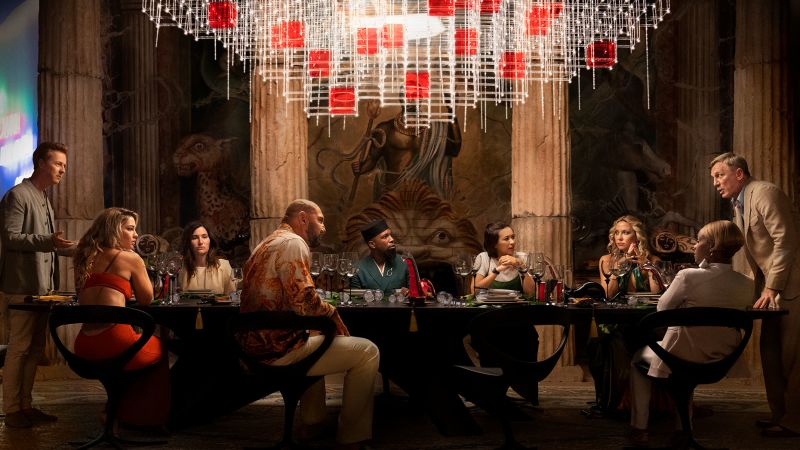In Easton’s “Oh, Say Can You See,” American and Confederate flags, whether painted or actual, represent a war that subliminally still rages. A red MAGA cap denotes the present, while a tree that bears the corpses of some two dozen lynching victims memorializes a shocking past. The artist’s style is precisely realistic, but some details are surreal, and the contrasts between the two are suitably jarring. As Easton’s statement puts it, his work “acts as a warning to the nation.”
Zughaib’s “Borders + Barriers: Pattern of Resilience” recasts IA&A’s middle gallery as a sort of white-walled detention center. The word “refugee” is emblazoned on the ceiling, and the phrase “border no entry” is posted on the emergency-exit door. Brightly painted children’s sneakers, one of the artist’s trademarks, trek across the wall in a futile quest for a safe haven. Zughaib combines colorful Islamic-style decorative patterns, also familiar from her earlier work, with black-and-white photographs of a Syrian refugee in Turkey and Haitians apprehended on the southern U.S. border. As the world converges, solutions seem only to recede.
Hair is a central motif in Honarmand’s “Screeching Silence,” inspired in part by the “Woman Life Freedom” protests after the 2022 death in police custody of Mahsa Amini, an Iranian Kurdish woman arrested for allegedly wearing her hijab improperly. The artworks, mostly soft and sinuous, include a video of hair-braiding and a flock of curving sculptures, modeled on Persian calligraphy and suspended overhead. Mounted in a partly darkened room, the forms cast shadows that evoke the ghostly realm inhabited by Iran’s women.
Kiana Honarmand: Screeching Silence; Helen Zughaib: Borders + Barriers: Pattern of Resilience and Mike Easton: Oh, Say Can You See Through June 30 at IA&A at Hillyer, 9 Hillyer Ct. NW. athillyer.org. 202-338-0680.
The trees in Sarah Hood Salomon’s photographs often appear venerable or even invincible. But trees are chopped down all the time, sometimes to be made into paper, the substance on which photos are most often printed. This fraught connection links the objects, not all of which can be described as pictures, in Salomon’s “Questioning the Photograph.” The Multiple Exposures Gallery show features black-and-white prints that have been cut, scratched, crumpled or shredded.
The artist’s inspiration was the imminent destruction of woods on land that’s about to be developed. Salomon represents the trees’ vulnerability by slicing a photo of them and arranging the pieces into a shrublike sculpture fixed by clear resin. Other pictures are reduced to ribbons or even dust and embedded within transparent blocks or orbs. Thus preserved, the pictures forfeit their essential character, just as trees lose their nature when turned into firewood or newsprint.
If demolition is the point of most of these pieces, the two scratched photos have a different feel. Salomon carves flurries of fine lines into the pictures in ways that complement rather than question the original composition. In “Counterpoint,” the incisions suggest the effect of wind, giving the photo a kinetic quality. While Salomon pointedly embalms many of her images of trees, this picture is swirlingly alive.
Sarah Hood Salomon: Questioning the Photograph Through June 30 at Multiple Exposures Gallery, Torpedo Factory, 105 N. Union St., Alexandria. multipleexposuresgallery.com. 703-683-2205.
The transformation of trees into paper is the subject of one of the more playful artworks in Rosemary Luckett’s “Nature Icons: Masks of the Great Face Behind.” In the collage-painting “TP Totem,” a rusty saw is flanked by stumps, each of them crowned with a roll of toilet paper. Influenced by byzantine orthodox icons and Native Alaskan masks, other pieces in this Touchstone Gallery show are more solemn. The Delaware artist’s verse complements the mixed-media pictures and 3D assemblages.
The components of Luckett’s sculptures, whether crafted or found, are diverse. Yet two motifs are common: leaves and human faces. One inspiration for this is the Yup’ik tradition of dancing while wearing masks that hide human features and honor nature spirits. The artist’s statement calls her creations “prayers of gratitude for life, and a summons to restore to the planet what humankind has taken from it.”
The latter outlook is explicit in “Crossroads at Sea,” in which oceanic creatures swim through a blue field overlaid with netting and interrupted by text and drawings of shipping containers. More characteristic, however, are images that evoke the sacred. Working mostly in earthly shades of green, blue and brown, Luckett renders nature iconic.
Rosemary Luckett: Nature Icons: Masks of the Great Face Behind Through June 30 at Touchstone Gallery, 901 New York Ave. NW. touchstonegallery.com. 202-682-4125.
Most of the oils in Jonathan Ege’s “Polaroid — Painted” were inspired by old photographs, but the local artist is no photorealist. The pictures in his Willow Street Gallery show include impressionistic portraits in which such facial features as a lush white-gray beard serve both as biographical details and occasions for exuberant brushwork. The goal is “to explore the eternal and the visceral by painting narratives of my emotional connections to friends,” says Ege’s statement.
The show does include one notable exception to that strategy. “After Mucha” shifts to an art nouveau mode to depict a woman, her head haloed, whose flowing gown dissolves into trailing gold and red tendrils that partly frame a watery landscape. This picture seems to derive from mythology rather than memory.
The act of painting itself is sometimes Ege’s subject, whether portraying an artist at his easel or a girl with the inevitable pearl earring in “After Vermeer.” The artist also revels in dramatic lighting effects, whether it’s the way a man’s face is illuminated as he fires up a pipe or the sunlight that outlines a boy’s body with a gentle sheen. That glimmer most likely appears in the original Polaroid, but it can also be seen as the glow of memory.
Jonathan Ege: Polaroid — Painted Through June 30 at Willow Street Gallery, 6925 Willow St. NW. dcartsstudios.org/gallery. 202-294-0271.



